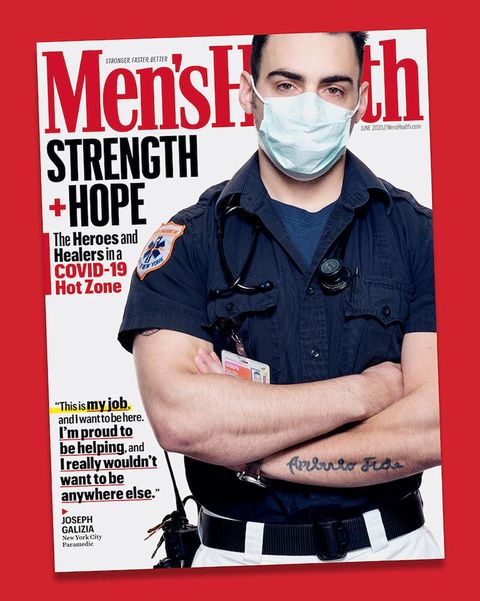Tear gas is technically a chemical weapon, and its use as a weapon is prohibited in armed conflict, according to the International Committee of the Red Cross. Yet it can be, and is, used as a riot control agent in numerous countries, including the U.S. (that’s what was recently used to disperse crowds in Lafayette Square in Washington, D.C. last Monday night).
Tear gas does a lot more to your body than just make your eyes tear. Here’s what tear gas is, what it does to your body, how to protect yourself, and what to do if you come in contact with it.
What is tear gas?
Tear gas can be composed of a few different chemical agents and it’s not technically a gas; it’s actually a powder that’s propelled into a spray that’s extremely irritating to the human body. “Tear gas should actually be thought of as a type of nerve agent that doesn’t just irritate cells, but activates specific pain receptors, (TRPV1, TRPA1) leading to the intense and burning pain on all affected surfaces and membranes,” Robert Glatter, M.D., Men’s Health Advisor and emergency physician in NYC, has told Men’s Health.
It activates when it comes in contact with a tiny amount of moisture on your skin, eyes, mouth, nose and lungs, explains Rohini Haar, MD, MPH, an emergency physician at Kaiser Medical Center in Oakland, and a research fellow at the Human Rights Center at the University of California, Berkeley, School of Law. Although it was developed about 100 years ago, “research around it is pretty limited. There’s no regulation and no transparency around its production, and there’s no research around what potency is safe or how they’ve proven it’s safe.”
What do you feel when tear gas is released?
Your eyes, nasal, and oral passages start burning. “It causes your eyes to spasm—it feels like there’s something in your eye and you can’t see straight and keep your eyes open. This causes people to feel really disoriented and agitated, especially since you can’t keep your eyes open long enough to run away. It inhibits people from orderly dispersal,” Dr. Haar says.
In your airways, the irritation triggers mucus, makes you cough, and makes breathing difficult—some people say it feels like they’re drowning. “Lung tissue is very sensitive and can be burned and injured pretty quickly,” says Dr. Haar. Children, the elderly, and people with asthma and other chronic respiratory conditions can be especially susceptible. Tear gas also causes skin irritation, sometimes so badly that there’s roughness, swelling and blistering. “People say it feels like their skin is going to burn off,” she adds.
Dr. Glatter notes that some people have died after being tear gassed. A study published in 2016 in the New York Annals of Science conducted by a collaboration of top universities states that “many believe the risks of tear gas exposure are understated and that perceived risks are based on insufficient human epidemiological and mechanistic data.”
So it’s important to protect yourself as much as possible and act quickly if you are exposed to it.
How can you protect yourself?
“Wearing eye protection and masks while protesting would be recommended,” says Dr. Haar. “Ski goggles would protect your eyes from getting any of the tear gas, but they tend to be disorienting and uncomfortable.” Safety glasses or sunglasses at least can protect you from getting any spray directly in your eyes. For COVID-19 protection, you’ll be wearing a mask, anyway.
To keep tear gas off your skin as much as possible, cover up—wear long sleeves and long pants. Amnesty International recommends avoiding oils and lotions, since they can trap the chemicals on your skin, prolonging the irritation.
Be aware that injuries can also occur from the propellent or bits of the canister that the tear gas is detonated from, and can burn you if you touch them. If you see one being launched, get out of the way. (For tips on other aspects of protesting, check our guide to protesting safely amid the pandemic.)
What to do if you’re tear gassed
“If you’re exposed to tear gas, get out of the space. You need to stop the exposure, then decontaminate,” says Dr. Haar. Move away and get as much fresh air as you can.
The CDC recommends getting to “the highest ground possible, because riot control agents will form a dense vapor cloud that can travel close the ground.”
Don’t rub your face or eyes, and if you wear contact lenses, remove them with clean hands. Amnesty International recommends that after you take care of any immediate medical needs, you should “start walking around with your arms outstretched” to take advantage of fresh air.
Tear gas sticks not only to skin but also to clothes, so as soon as you can, remove contaminated clothing. Try not to pull your clothes over your head in order to prevent getting more in your eyes and mouth. Flush your eyes with water, recommends Dr. Glatter—don’t just rinse them quickly from a water bottle. You may need several liters to rinse them—Amnesty International recommends irrigating by tilting your head back and slightly toward the side being rinsed and irrigate the eye from the inside corner of the eye toward the outside.
Take a cold shower as soon as you can—warm water opens your pores and lets the chemical into them—and wash your clothes. It may take more than one wash to get the chemicals out. In fact, “some of the new tear gasses are designed to be more potent and have a longer shelf life. These can stay on surfaces—if you kick it up a few days later, it could still make you symptomatic,” Dr. Haar says.
“Eventually, your body breaks down the chemicals,” says Dr. Haar, and the sensations subside. If you’re having issues with vision within about 30 to 60 minutes of good decontamination efforts, seek medical attention. Always seek help if you’re having significant breathing issues.
Source: Read Full Article

